| |
Football League Review
Introduction
The Football League Review was a magazine produced between 1965 and 1975 and uniquely was given away free inside match programmes during that period. The Football League took over production of the magazine after the first season and used it to promote issues close to their heart (and business), such as hooliganism and the League Cup.
The magazine neatly straddled the changes in society as England finally shrugged off the black and white post-war era of suits and neat hair, and moved towords the more colourful and flamboyant entertainers of the 1970s. It straddled the World Cup win and Mexico defeat, decimalisation and the Beatles, Soccer Specials, Watney & Texaco Cups, Brian Clough & Bill Shankley, European Football and of course the changing profile of the fans.
The magazine is best remembered not for the sometimes turgid articles, but for the colour team photos included in each issue. Fans from that era well remember the thrill of finally seeing their own team featured at a time when their own club's programme rarely featured any colour other than on the cover.
This section aims to pull together the interesting bits from the magazine, an archive which as far as we know does not currently exist anywhere else on the web. We will be leaving out the ads featuring men smoking pipes while women look on adoringly, and instead will be bringing you the various collections and features from across all 366 issues. We will be focusing on the covers first and then the colour pictures - each issue was traditionaly a mix of 8 colour pages including the cover, with the rest in black and white - and may then move on to some of the articles if time allows.
Series Summary
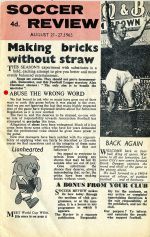 |
|
Series 0
1965/66 |
|
16 pages, black and white with different block colour behind title on each front cover. Pipes, side-partings and casual sexism. Small team of the week photo. Articles, news about fans, players, teams, editor Harry Brown's 'As I See It'. More content than the average programme at the time. |
|
| |
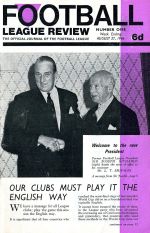 |
|
Series 1
1966/67 |
|
Now run by the Football League, hence the new name. 16 pages of black and white but with a different block colour used each week used on several pages. 2 page Club Call feature on a team, Club Directory detailing admission prices, addresses and phone numbers, letters, News Desk from League HQ, action photo. |
|
| |
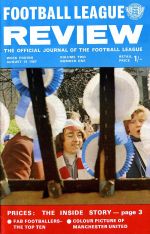 |
|
Series 2
1967/68 |
|
Expanded to 20 pages, with 4 in full colour; Cover, Star Pix featuring a couple of players, inside back cover team picture and an ad on the back page. Glossy paper throughout replacing the newspaper from the previous series. Club Call, Post Bag, stats and results, meet the ref, columns and news. Much more interesting than the average programme, which is probably why it was now included with the majority of them. Suddenly the 8 or 10 page blac and white ad and team sheet contained colour and articles that took more than 5 minutes to read.
The cover design was changed mid way through the season and the popularity meant 4 more colour pages were added later on, presumably driven by the possibility of extra colour ads. The side effect of this for the fan was the first of the popular centre page team pictures. |
|
| |
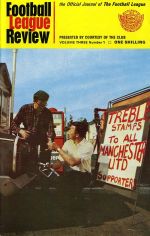 |
|
Series 3
1968/69 |
|
Another increase in size, to 24 numbered pages with 7 usually in colour, and blocks of colour elsewhere. Soccer Strip series - guess the team from the kit, ask the ref, League View, Harry Brown's column, fans of the week, celebrity fans, Club Call, stats, Press Box, Tip for the Top, colour picture of a player and centre page. Like the previous series, these mirror society at the time and are as interesting for that as for the actual views expressed. |
|
| |
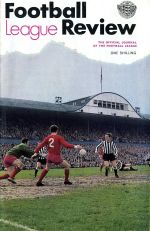 |
|
Series 4
1969/70 |
|
Down to 20 pages again but 8 in colour. Non-colour pages no longer glossy. A change in focus to feature players and match action on the cover. The popular features - Club Call, centre spread featuring a team photo - were coupled with a series featuring club badges in colour, soccer-vision featuring small photos from games with captions, plus League View, Post Bag and Over The Bar - you ask the questions.
This series had the feel that enthusiasm had peaked and the cost of producing it was perhaps not being covered by the advertising generated. A change in focus from fans to players and clubs was welcome for most readers. |
|
| |
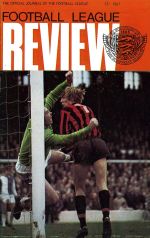 |
|
Series 5
1970/71 |
|
20 pages, still with 8 in colour. More ads but still the centre page team photo and a colour page featuring a ground. Stats, Programme Review, Current Affairs, Football League Viewpoint and Postbag. The magazine feels poorer quality but some of the articles are still interesting if you avoid the self-publicising by the League. |
|
| |
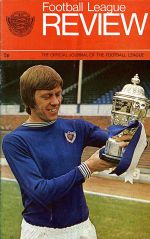 |
|
Series 6
1971/72 |
|
Up to 24 pages again, still with the cover and centre pages in colour. The magazine has a more cohesive feel as the same typeface has been used for the page headings for the first time. Colour team shot in the centre and a player on the inside back cover. |
|
| |
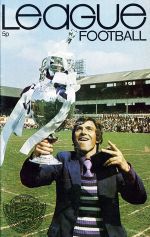 |
|
Series 7
1972/73 |
|
The same format as Series 6, albeit with a shortened name and more modern type face. 24 pages, 8 in colour. Alan Hardaker now has his own credited page rather than ghost writing before. Articles mainly about players and clubs, with some statsand the Post Bag. Occassional single page colour team photos in place of a player shot on the inside back cover. |
|
| |
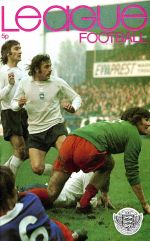 |
|
Series 8
1973/74 |
|
16 pages, half in colour but it's clear the League was losing interest in the Review. A few interesting articles, colour picture of a ground (Soccer Homes) and a player, plus an action shot and the team picture in the centre. Much reduced content due to smaller size.
However, midway through the season the size increased agin to 24 pages with bigger print at times but more content. Was the Review going to make a comeback? |
|
| |
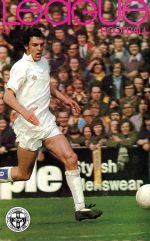 |
|
Series 9
1974/75 |
|
Unfortunately the Review was not going to last. Down to 16 pages again at the start of the season, albeit on better quality paper, time was called with issue number 20. Alan Hardaker blamed the increased cost of printing against reduced advertising revenue, but also the unwillingness of clubs to pay more for what had become a reduced magazine. Clubs were improving their own publications by this time so probably felt they no longer needed to pay to include the League's mouthpiece as well. |
|
Numbering
Early issues of the review were both numbered and dated on the cover, making them easy to date. When the Football League took over, they started with Series 1, hence our calling the previous season Series 0.
Each issue was included free with programmes issued for that 7 day period. If you just attended home games you were therfore likely to read every other issue.
From Series 4 onwards, the only indication of an issue number is in the bottom right-hand corner of the back cover. Each issue was numbered chronologically, starting with 401 up to 435. Series 5 started at 501 and ran to issue 538 and so on up to the last issue, 920.
There were some exceptions, with special issues being produced during each season. These were given letters instead of numbers, eg 40A. 40B etc. We are trying to date each of these specials - if you have programmes still containing any of these issues and can tell us the date of the game it will help us to catalogue them correctly. * John Wells has been in touch and confirmed from his collection that issue A was used by clubs who played away on the first Saturday of the season, but were then home for a mid-week League Cup tie. Issue B is similar for the FA Cup 1st round where a League club had drawn away against a non-League club on the Saturday, and then had the mid-week replay at home. Issue C was for the extra game over Xmas / New Year. Issue D was for the third game played over Easter.
|





















